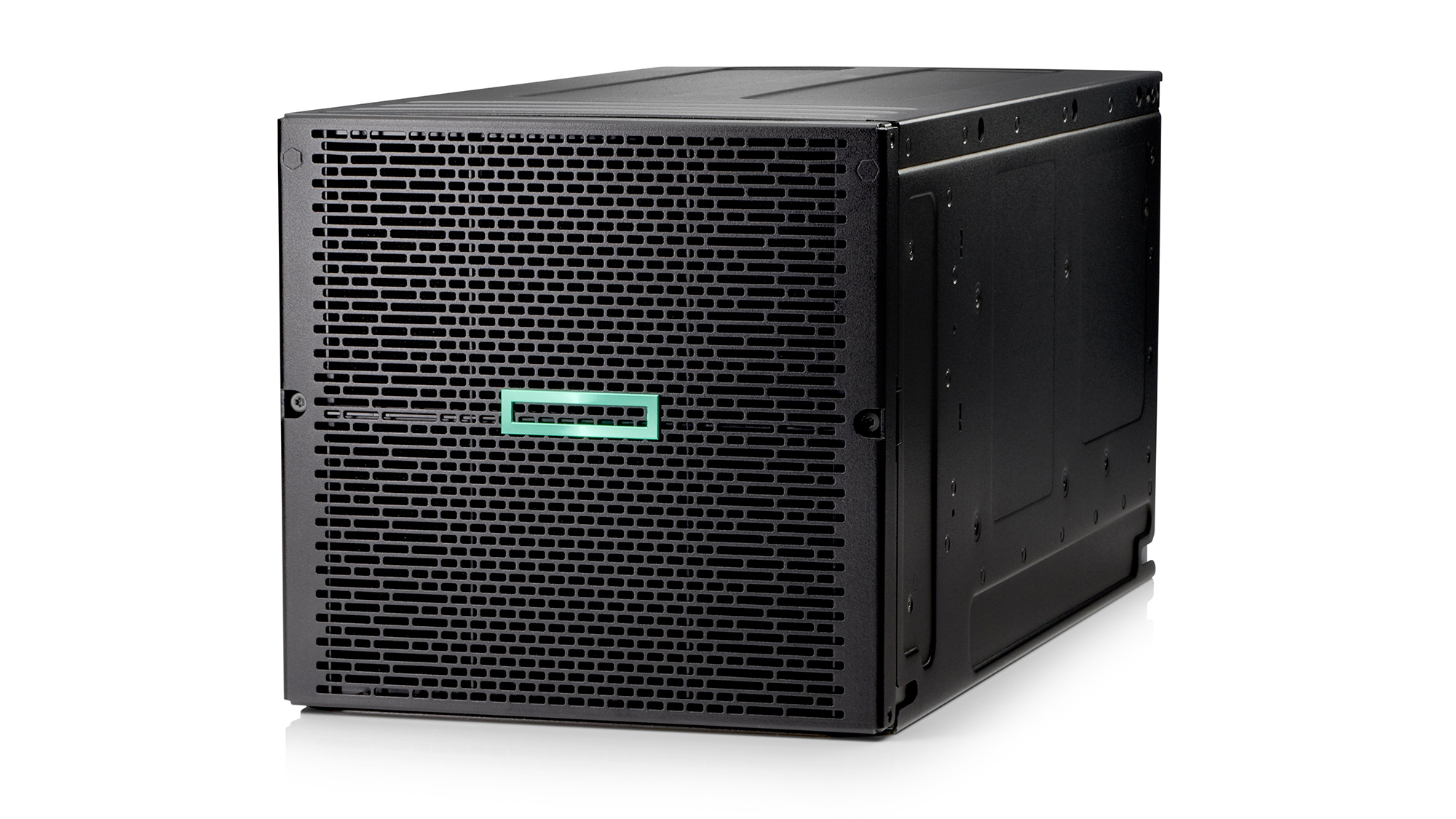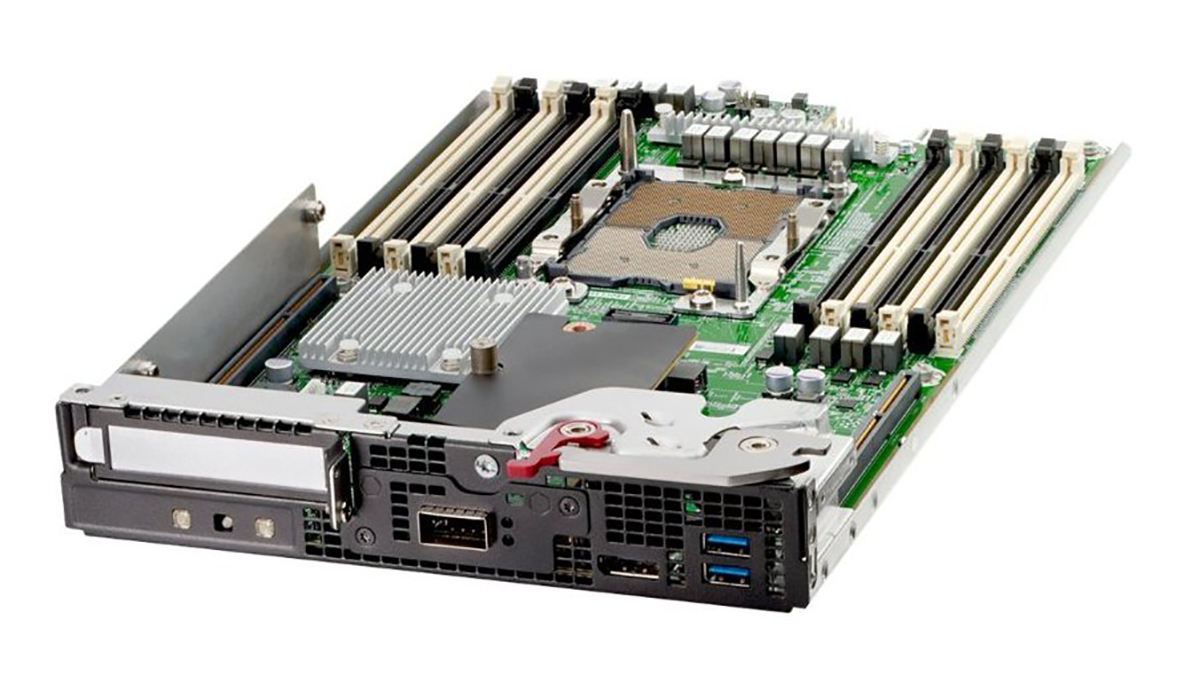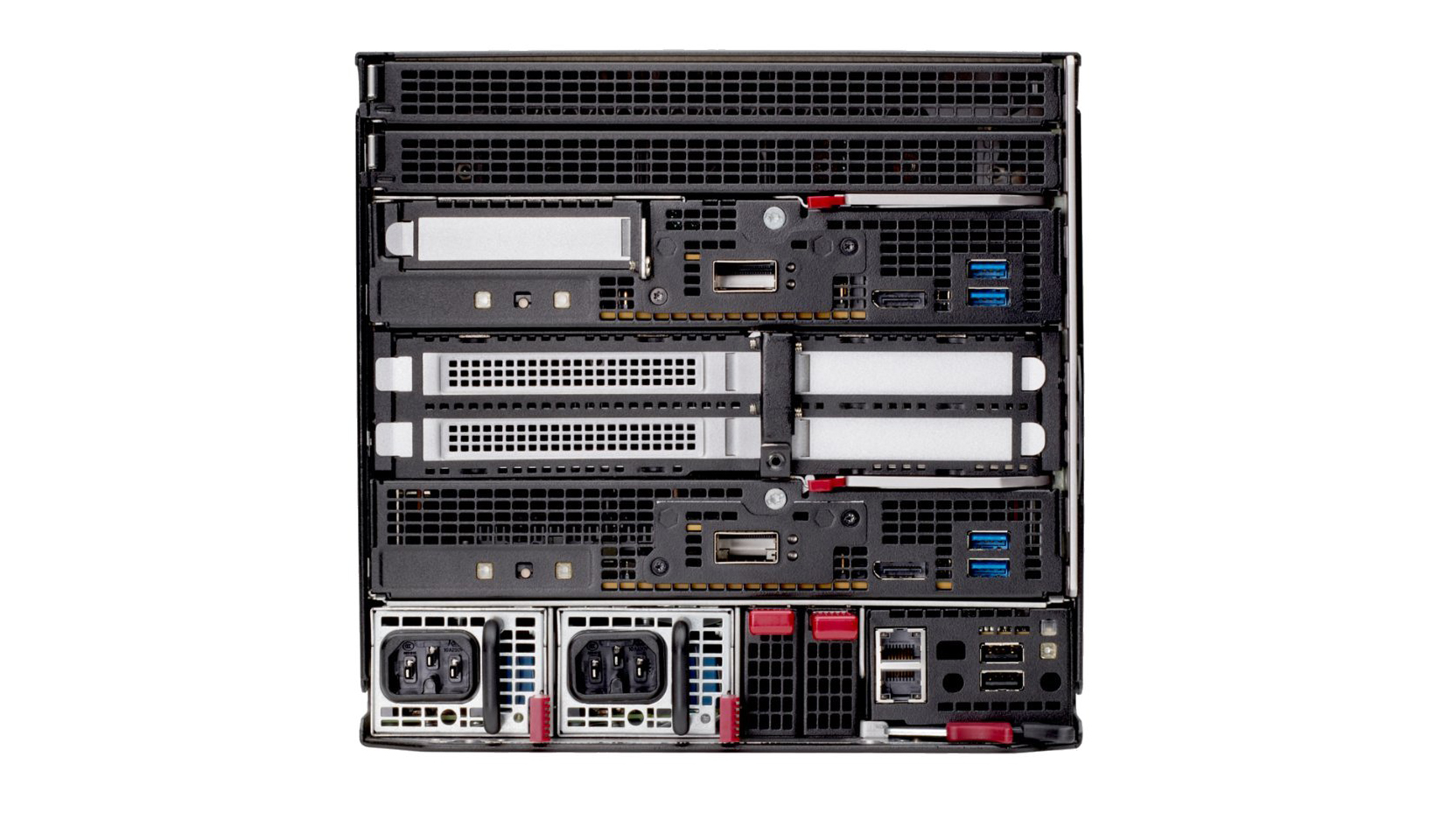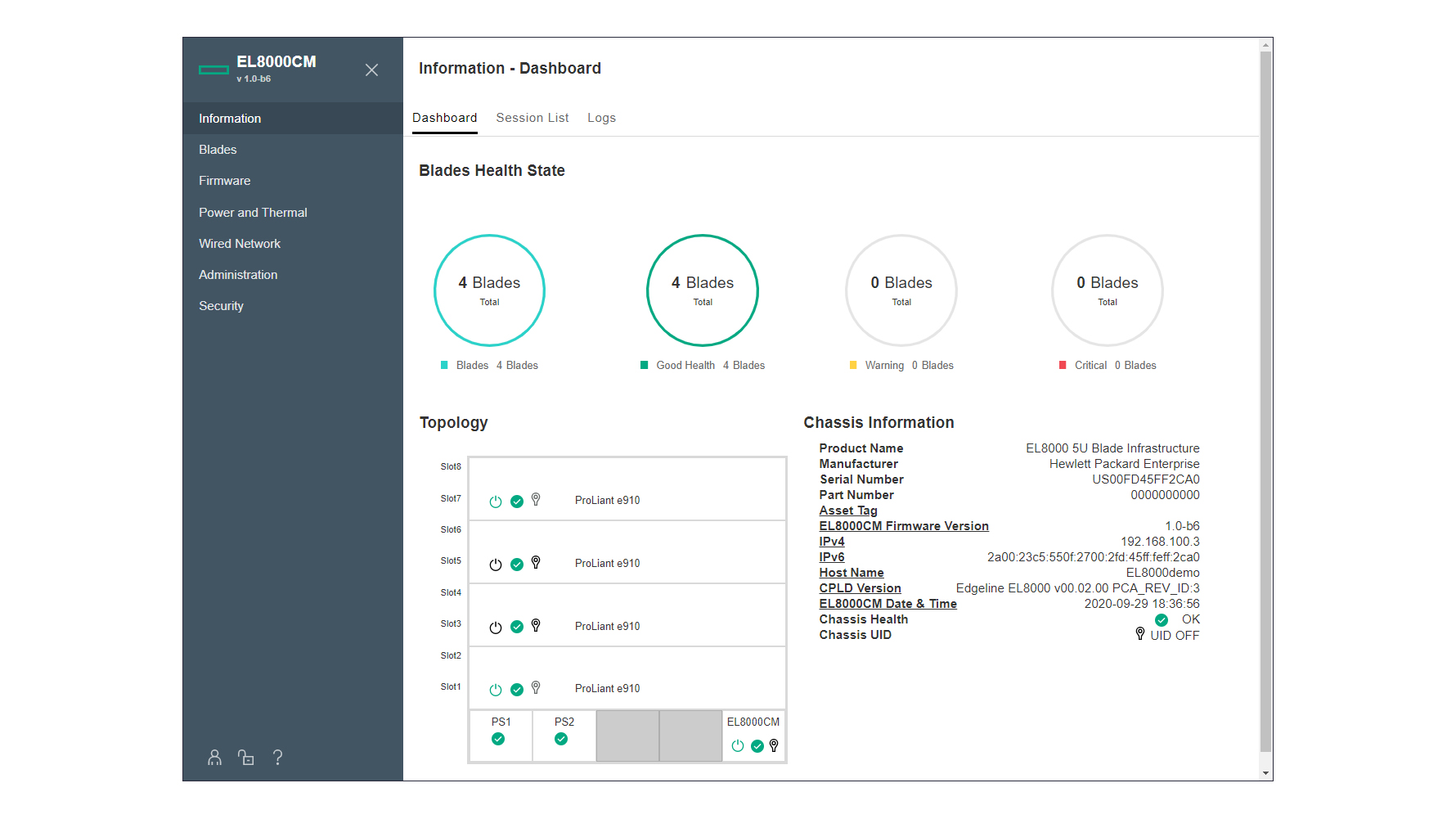HPE EdgeLine EL8000 review: Trains and boats and planes
This rugged server pushes powerful Xeon Scalable processing to the edge


-
+
Tough build quality
-
+
Flexible modular design
-
+
Expandable server blades
-
+
Supports Xeon Scalable CPUs
-
+
High memory capacity
-
+
Great remote management
-
-
HPE’s Intelligent Provisioning can’t deploy an OS on NVMe-only storage

As data generation inexorably moves out to the network edge, many businesses want to follow it with systems that can process data in situ instead of pushing it all the way back to the data centre or cloud. HPE has been in the edge computing game longer than most, having launched its EdgeLine series a few years ago - although some models are already a bit long in the tooth.
The EdgeLine EL8000 ups HPE’s game, delivering a high performance edge compute solution in a compact and rugged 5U half-width chassis. Naturally, 5G adoption is a key focus for HPE but it has many other target markets for the EL8000 including retail, manufacturing, transportation, defence and energy production.
Whereas the EL1000 and EL4000 systems employ HPE’s old Moonshot Xeon D and Xeon E3 server cartridges, the EL8000 gets a brand new purpose-built server blade. It supports up to four ProLiant e910 blades, making the EL8000 one of the first solutions to deliver Xeon Scalable computing to the network edge.
HPE EdgeLine EL8000 review: Chassis design
The EL8000 is designed for harsh environments – it’s shock and vibration resistant and rated for continuous operations in temperatures between 0 and 55 degrees C. The 5U chassis can be deployed as a standalone unit or rack-mounted, where you can place two alongside each other and even a third sideways on behind them.
The four upper 1U slots each accept an e910 blade and if you want more options, you can mix them with 2U versions which double the number of PCI-E slots. All system cooling is handled efficiently by an array of nine hot-plug cooling fan modules at the rear.

Two 1,500W hot-plug PSUs slot into the lower 1U space and alongside there’s room for up to two unmanaged 10GbE switch blades. Tucked up in the lower right-hand slot is HPE’s ECM (EdgeLine chassis manager) module which provides web browser access for managing the chassis, monitoring the blades and controlling power.
HPE offers a range of casing options for the EL8000; a 19in wall-mount enclosure allows two to be placed side by side, or you can go for a shipping container so the system can be delivered and operated without unpacking it. Our review unit was supplied in a battle-hardened aluminium wheeled case and it can be protected out in the field with a rugged, water-resistant version.
HPE EdgeLine EL8000 review: The e910 blade
The ProLiant e910 server blades pack a lot into their compact dimensions, with the single Xeon Scalable CPU socket located at the rear and flanked on each side by six DIMM slots. Further forward are two PCI-E expansion slots plus a dedicated slot in the middle for an optional mezzanine card.
The blades have an embedded Gigabit port which can be accessed from the ECM, as it uses its second Gigabit maintenance network port to aggregate all four connections. More importantly, they each have an Intel X722 quad 10GbE backplane connection where two can be routed through to the unmanaged network switch blades which terminate them on a 10GbE SFP+ port.
If you install the quad 10GbE mezzanine card, its QSFP+ port is presented at the front of the blade. This doesn’t go through the switch module though, so you’ll need to use HPE’s direct-attach breakout cables to split it into four external 10GbE ports.

The blades only support M.2 SATA or NVMe SSD storage, and have two on-board 2280 slots. This can be easily trebled with a riser adapter that fits over the top of the mezzanine card and supports longer 22110 M.2 cards.
The 2U server blades are essentially the same, with the main difference being that they have an extra 1U upper unit which provides four PCI-E slots. The chassis also supports a 2U storage bay providing 8 SFF hot-swap bays plus Smart Array controller. This is available as a factory order and can only be used with one 2U e910 server blade.
HPE EdgeLine EL8000 review: System management
The blades each have an embedded iLO5 management controller with all of them piped through the ECM’s network port. It presents a smart web console packed with information about server blade status and essential details on critical components.
We did come across one glitch though; we were unable to use HPE’s Intelligent Provisioning tool to deploy Windows Server 2019. This tool expects to see a Smart Array controller and with NVMe-only storage available on our blades, it refused to proceed, requiring us to manually deploy the OS from a mapped ISO file and apply all necessary drivers.
The chassis management web interface is very informative and opens with a dashboard view of blade health status and an active graphic of the chassis with all installed components. More information is available on the blade summary page and each entry provides a direct link to their iLO5 interface.

Clicking on a blade entry takes you to its personal power controls so you can gracefully bring the blade down, reset it or recycle power. Usefully, you can select a one-time boot option without visiting the iLO5 interface.
Strong platform security extends to silicon root of trust fingerprinting for the chassis and blades so you know their firmware hasn’t been compromised. The ECM supports SSH access and maintains audit logs, while the iLO5 chip allows administrators to use SSO to manage user access to all blade features and offers four encryption levels - including the highly secure FIPS and CNSA modes.
HPE EdgeLine EL8000 review: Verdict
The EdgeLine EL8000 shows HPE is getting very serious about edge computing. This 5U system delivers a smart modular design, allowing it to be customised to suit specific scenarios and the e910 blades are amongst the first to put Xeon Scalable CPUs close to the edge.
Network options are extensive and the e910 blade design and features allow you to create a high performance solution capable of running many enterprise apps. Its rugged design allows it to go places other servers daren’t venture, and HPE offers a wide range of portable, battle-ready transport cases for ‘deliver and deploy’ services.
HPE EdgeLine EL8000 specifications
| Chassis | 5U half-width rack mount |
| Server blade slots | 4 x 1U |
| Management | HPE EdgeLine Chassis Manager (ECM) module |
| Switch slots | 2 x 10GbE Unmanaged |
| Power | 2 x 1,500W hot-plug PSUs |
| Cooling | 9 x hot-plug fan modules |
| Server blades | Up to four with the following features |
| CPU | 1 x Xeon Scalable 4200, 5200, 6200 or 8200 |
| Memory | 12 x DDR4 DIMM slots |
| Storage | 2 x embedded M.2 SATA/NVMe SSD 2280 slots |
| Network | 1 x Gigabit, 4 x 10GbE (backplane) |
| Expansion slots | 1 x mezzanine, 2 x PCI-E 3 (1U), 4 x PCI-E 3 (2U) |
| Blade management | HPE iLO5 Advanced |
| Warranty | 3yr on-site NBD |
Get the ITPro daily newsletter
Sign up today and you will receive a free copy of our Future Focus 2025 report - the leading guidance on AI, cybersecurity and other IT challenges as per 700+ senior executives
Dave is an IT consultant and freelance journalist specialising in hands-on reviews of computer networking products covering all market sectors from small businesses to enterprises. Founder of Binary Testing Ltd – the UK’s premier independent network testing laboratory - Dave has over 45 years of experience in the IT industry.
Dave has produced many thousands of in-depth business networking product reviews from his lab which have been reproduced globally. Writing for ITPro and its sister title, PC Pro, he covers all areas of business IT infrastructure, including servers, storage, network security, data protection, cloud, infrastructure and services.
-
 Global cybersecurity spending is set to rise 12% in 2025 – here are the industries ramping up investment
Global cybersecurity spending is set to rise 12% in 2025 – here are the industries ramping up investmentNews Global cybersecurity spending is expected to surge this year, fueled by escalating state-sponsored threats and the rise of generative AI, according to new analysis from IDC.
By Ross Kelly Published
-
 ‘Phishing kits are a force multiplier': Cheap cyber crime kits can be bought on the dark web for less than $25 – and experts warn it’s lowering the barrier of entry for amateur hackers
‘Phishing kits are a force multiplier': Cheap cyber crime kits can be bought on the dark web for less than $25 – and experts warn it’s lowering the barrier of entry for amateur hackersNews Research from NordVPN shows phishing kits are now widely available on the dark web and via messaging apps like Telegram, and are often selling for less than $25.
By Emma Woollacott Published
-
 Redis unveils new tools for developers working on AI applications
Redis unveils new tools for developers working on AI applicationsNews Redis has announced new tools aimed at making it easier for AI developers to build applications and optimize large language model (LLM) outputs.
By Ross Kelly Published